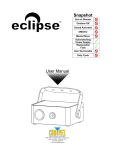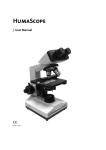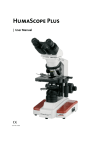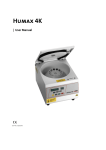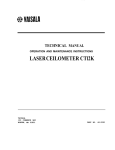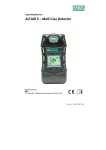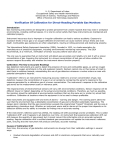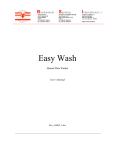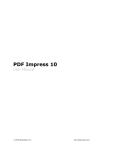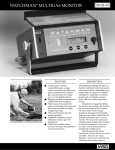Download Portable Instrument Calibration
Transcript
calculated based on their loss record for 1998, 1999 and 2000. Experience Modification Factors can increase or reduce premiums by an average of 10 to 25 percent, making them worthy of a company's attention. Indirect Cost Savings: Lost Employee Time and Lost Job Bids In addition to saving on premiums, a company can also cut costs by reducing the lost work time of its employees. Taking active measures to minimize workplace accidents and injuries is one of the most effective ways to achieve this. If an experienced employee cannot work because of an accident or incident, the company suffers from a "loss of efficiency", becoming less productive. When the position is essential to the company's operations, and cannot remain open until the employee returns to work, then the employer must pay to replace that employee and/or train another employee to fill in. Since replacement and training costs can be very high, this is another area in which a company can save money by reducing its number of accidents and injuries through proper, regular instrument calibration. In addition to lost employee time, indirect effects of workplace accidents and injuries can potentially extend to include a loss of the company's market share and degraded customer confidence, due to reduced output, reduced quality and increased costs, which can lead to smaller profit margins or increased product pricing. In addition to a possible three-year negative effect on the bottom line, a poor e-mod. can also haunt manufacturers and service providers in situations where there is close competition for business. In these cases, a review of the bidder's qualifications may be requested, which often includes their safety history. The OSHA Process Safety standard is one of the forces behind such reviews. It requires chemical and petrochemical manufacturers to be responsible not only for their own safety record, but also for the safety records of the various contractors and suppliers employed to work on their premises. A contractor's or supplier's e-mod. is therefore routinely asked for by many employers who are subject to this standard. In competitive situations where bids are relatively equal but "Contractor A" has a favorable e-mod. of 0.8, while "Contractor B" has a negative e-mod. of 1.8, the better emod. may well be the deciding element. Regular Instrument Calibration: A Procedure You Can Live With As you can see, there are many reasons for a company to implement and enforce regular, proper instrument calibration procedures. By doing so, they help guard the safety of their workers and property while also achieving significant financial savings. All of this—from an act that can take just minutes a day. Note: This Bulletin contains only a general description of the products shown. While uses and performance capabilities are described, under no circumstances shall the products be used by untrained or unqualified individuals and not until the product instructions including any warnings or cautions provided have been thoroughly read and understood. Only they contain the complete and detailed information concerning proper use and care of these products. ID PR 08-0034 / May 2001 © MSA 2001 Printed in U.S.A. Corporate Headquarters P.O. Box 426 Pittsburgh, PA 15230 USA Phone 412-967-3000 www.MSAnet.com U.S. Customer Service Center Phone 1-800-MSA-2222 Fax 1-800-967-0398 MSA Canada Phone 800-267-0672 FAX 416-663-5908 MSA Mexico Phone 01-800-71-754-11 Selecting an Instrument - Calibration Safety Issues In the past few years, much work has gone into simplifying the instrument calibration procedure. From a safety standpoint, there is still no substitute for having a welltrained technician adjust the reading of an instrument to a known concentration of gas. With today's microprocessors, however, the alternatives can be equally effective, given appropriate training. Portable Instrument Calibration Some questions to ask before buying your next gas detector: 1. Does the detector have appropriate levels of tamperresistance to prevent users from inadvertently entering calibration mode? An instrument's degree of tamper-resistance should be closely matched to the experience and training of the end-users. Prevention of inadvertent adjustments by untrained users may be of utmost importance to many companies, so be sure to carefully consider a detector's "lockout" capabilities. 2. Does the autocalibration on your monitor have adequate safety limits? The greatest change in calibration in the last 5 years has been the advent of autocalibration, which typically allows the user to press a sequence of buttons to enter calibration. The instrument software then automatically adjusts the "span" readings to preset concentrations. When performing an autocalibration, the instrument software limits the amount of adjustment that can be made to the sensor to an acceptable range above and below the factory setting. These limits are known as the autocalibration safety limits. The autocalibration safety limits are designed to allow calibration of the instrument when an expected amount of sensor drift has occurred and to prevent calibration should a calibration error or other problem requiring additional instrument servicing exist. Therefore, it is important to ask the manufacturer what limits they have on the autocalibration adjustments. . . . . . . . Saving lives... and more 3. Can autocalibration be disabled? For some users, the ability to prevent unauthorized adjustments to the meter's calibration may be very important. Be sure to verify this capability if such protection is part of your safety program. 4. Does it have an automated calibration system available? Automated, computer-based calibration systems are becoming more common. From a safety standpoint, the main advantage of these systems is their repeatability. They can be less prone to individual user error and can help assure proper calibration of medium to large fleets of instruments. These systems can also be of great assistance in formal confined space programs by providing, in some cases, automatic storage of calibration records. MSA International Phone 412-967-3354 Fax 412-967-3451 Offices and representatives worldwide For further information: Rick Hartman Product Line Manager William Berner Risk Manager · The Benefits of Regular Portable Instrument Calibration I. Worker Safety II. Financial Incentives A. Reduced Worker Compensation Premiums B. Reduction of Lost Employee Time and Lost Job Bids Bump Tests vs. Full Calibration There are two methods of verifying instrument calibration: a functional or "bump" test and a full calibration. Each is appropriate under certain conditions. Calibration: The Key to Accurate Readings Gas detection instruments are used to detect low levels of toxic and combustible gases, and oxygen deficiency or enrichment (an explosion hazard). Since users cannot rely on their sense of smell to alert them to odorless hazards, gas detectors are necessary whenever a worker enters an area with the potential for atmospheric hazards. Most instruments are equipped with both a warning and an alarm condition. The warning condition alerts the user that the environment has a low concentration of gas and is therefore potentially hazardous; the alarm condition indicates that the gas concentration exceeds the programmed "hazard" threshold and the area is approaching a hazardous level. Whether an instrument warns and/or alarms at the proper time depends not only on its detection abilities but also on its ability to translate its findings into an accurate reading. A bump test is a means of verifying calibration by exposing the instrument to a known concentration of test gas. The instrument reading is then compared to the actual quantity of gas present (as indicated on the cylinder). If the instrument's response is within an acceptable range of the actual concentration, then its calibration is verified. When performing a bump test, the test gas concentration should be high enough to trigger the instrument alarm. If the bump test results are not within the acceptable range, then a full calibration must be performed. A full calibration is the adjustment of the instrument's reading to coincide with a known concentration (generally a certified standard) of test gas. In most cases, a full calibration is only necessary when an instrument does not pass the bump test (or after it has been serviced). (For recommended calibration frequency and procedures see box, "When Should You Bump Test? When Should You Calibrate?") "Calibration" refers to an instrument's measuring accuracy relative to a known concentration of gas. Gas detectors perform relative measurements: rather than independently assessing the quantity of gas present, they measure the concentration of the air sample and then compare it to the known concentration of the gas the instrument is configured to sample. This known concentration serves as its measurement scale, or reference point. If the instrument's reference point has moved, then its reading will also move. This is called "calibration drift" and happens to most instruments over time. When an instrument experiences calibration drift it can still measure the quantity of gas present, but it cannot convert it into an accurate numerical reading. Regular calibration with a certified standard gas concentration updates the instrument's reference point, re-enabling it to produce accurate readings. The Importance of Proper Regular Calibration The Number One Reason: Worker Safety The primary reason for proper, regular instrument calibration is to prevent inaccurate gas concentration readings that could lead to the injury or even death of workers and other personnel. Correct calibration of an instrument helps ensure that the instrument will accurately respond to the gases that it is designed to detect, warning users of hazardous conditions before they reach dangerous levels. In addition to detecting and correcting for calibration drift, regular calibration assures the user that the instrument is functional. Gas detection instruments are often subjected to harsh operating and storage conditions where they can be damaged. Through visual inspection a unit may appear to be fine but could actually be damaged internally. Any of these factors could affect instrument performance, leading to inaccurate readings or even instrument failure. Regular calibration is the only way to be certain that a detector is fully functional. What Causes Calibration Drift? Over time, gas detection instrument readings can fall out of their calibration specifications in several ways: · · Harsh storage and operating conditions (e.g., instrument is dropped, submerged in liquid). (If a sensor has been severely damaged it may need to be replaced. In this case, when calibration is attempted the instrument will either display a failure message or it will not allow the user to fully adjust the display reading.) Normal degradation of electrochemical sensors (used for toxic gas and oxygen detection). This is the major cause of calibration drift. Low humidity and high temperatures can cause more rapid electrolyte consumption. Regular calibration procedures and enforcement also set the tone for a safety-conscious work environment. Workers are reminded daily that their company makes safety a priority, making workers more likely to keep safety principles in mind throughout the workday. Exposure to sensor poisons—materials that are harmful to the sensor. 2 The Financial Incentive for Calibration When Should You Bump Test? When Should You Calibrate? In addition to injuring people, workplace accidents can damage equipment, machinery, building structures and other company assets. Effective safety procedures, including regular instrument calibration, can help reduce the number and severity of such events. But in addition to preserving worker and plant safety, companies can also benefit by recognizing several strong financial incentives for performing regular calibration. These incentives can be divided into two categories: "Direct cost savings" and "Indirect cost savings". In the past, there has often been confusion regarding proper calibration procedures and frequency. To clarify this issue, the International Safety Equipment Association (ISEA) has issued a position statement on instrument calibration for use in confined spaces. Direct Cost Savings: Reduced Worker Compensation Premiums According to this document, "A bump test or full calibration of direct-reading portable gas monitors should Instrument inaccuracy due to improper calibration or a lack of regular calibration can lead to serious accidents. Exposure to excessive levels of toxic gas can cause workers serious illness and even death. Combustible gas explosions are often catastrophic, injuring or killing personnel and destroying property. In the United States, an employer's worker compensation costs are generally loss experiencerated, so the higher the number and greater the severity of accidents, the higher a company's worker compensation premiums will be. be made before each day's use in accordance with manufacturer's instructions, using an appropriate test gas." If the instrument fails the bump test, it must be adjusted through a full calibration before it is used. ISEA recommends more frequent testing if sensor contaminants may be present. In their calibration statement, the ISEA allows for less The worker compensation premium calculation is fairly straightforward. There are designated classes of employment (i.e., manufacturing, driver, clerical, sales), and each is assigned a specific base rate. These rates vary for the different job classes, according to the calculated "risk" level for each: job classes in which workers are more likely to be involved in accidents are higher risks and therefore have higher rates, and vice versa. This set rate for each class of employment, combined with a few other items, is then multiplied by each $100 of payroll for all of the company's employees in that job class. The resulting number is the subtotal for that employment class. frequent calibration verification under certain conditions (see below). However, the time interval between checks should never exceed 30 days. If conditions do not permit daily testing to verify calibration, less frequent verification may be appropriate if the following criteria are met: 1. This subtotal is then multiplied by the company's "Experience Modification Factor" (e-mod.). The e-mod. is company-specific and reflects an individual employer's loss experience relative to that of other employers in a similar class of business. An e-mod. of 1.0 means that an employer's loss record is about average. An e-mod. of less than 1.0 means that their loss record is better than average, average, and one greater than 1.0 means that their loss record is worse than average. average. Since a company's base premiums are multiplied by its e-mod., not only does a higher factor increase rates—a lower factor decreases them. The difference between premium costs for a company with a good safety record and one with a poor safety record can therefore be quite significant. For example, "Employer X" has an e-mod. of 0.75 and "Employer Y" has an e-mod. of 1.75. If their employment class rates are both $1,000, then their premiums are: (Emp. X) .75 x $1,000 = $750;; (Emp. Y) 1.75 x $1,000 = $1,750—over —over a 100% difference! And of course, regularly practicing proper safety measures (including instrument calibration) certainly benefits a company's safety record. During a period of initial use of at least 10 days in the intended atmosphere, calibration is verified daily to be sure there is nothing in the atmosphere that is poisoning the sensor(s). The period of initial use must be of sufficient duration to ensure that the sensors are exposed to all conditions that might have an adverse effect on the sensors. 2. If the tests demonstrate that it is not necessary to make adjustments, then the time interval between checks may be lengthened but should not exceed 30 days. When calibrating an instrument, always consult the instrument user's manual for the manufacturer's recommended calibration procedure. For verification of accuracy, calibration gas should always be certified and If that isn't incentive enough, it's also important to understand that since e-mods. are based on 3-year periods, a poor modification factor can have a dramatic effect on not just one year—but three years—of years—of a company's premiums. For instance, a company's 2001 e-mod. is traceable to the National Institute for Standards and Traceability (N.I.S.T.). 3



